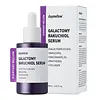What's inside
What's inside
 Key Ingredients
Key Ingredients

 Benefits
Benefits

 Concerns
Concerns

 Ingredients Side-by-side
Ingredients Side-by-side

Galactomyces Ferment Filtrate 95%
HumectantNiacinamide
SmoothingBakuchiol
AntimicrobialPanthenol
Skin ConditioningCollagen
Moisturising1,2-Hexanediol
Skin ConditioningHydroxyacetophenone
AntioxidantSimmondsia Chinensis Seed Oil
EmollientTocopheryl Acetate
AntioxidantPropanediol
SolventButylene Glycol
HumectantCentella Asiatica Extract
CleansingCarbomer
Emulsion StabilisingAlgin
MaskingCeramide NP
Skin ConditioningCannabis Sativa Seed Extract
EmollientAdenosine
Skin ConditioningGeranium Maculatum Oil
MaskingGalactomyces Ferment Filtrate 95%, Niacinamide, Bakuchiol, Panthenol, Collagen, 1,2-Hexanediol, Hydroxyacetophenone, Simmondsia Chinensis Seed Oil, Tocopheryl Acetate, Propanediol, Butylene Glycol, Centella Asiatica Extract, Carbomer, Algin, Ceramide NP, Cannabis Sativa Seed Extract, Adenosine, Geranium Maculatum Oil
Aloe Barbadensis Leaf Juice
Skin ConditioningHelianthus Annuus Seed Oil
EmollientGlycerin
HumectantBakuchiol
AntimicrobialSqualane
EmollientNiacinamide
SmoothingTocopherol
AntioxidantUbiquinone
AntioxidantSodium Hyaluronate
HumectantGlycyrrhiza Glabra Root Extract
BleachingKojic Acid
AntioxidantRaspberry Ketone
MaskingLavandula Angustifolia Flower Oil
MaskingPelargonium Graveolens Leaf Oil
Xanthan Gum
EmulsifyingLauryl Glucoside
CleansingMyristyl Glucoside
CleansingPolyglyceryl-6 Laurate
EmulsifyingCaprylhydroxamic Acid
Glyceryl Caprylate
EmollientAloe Barbadensis Leaf Juice, Helianthus Annuus Seed Oil, Glycerin, Bakuchiol, Squalane, Niacinamide, Tocopherol, Ubiquinone, Sodium Hyaluronate, Glycyrrhiza Glabra Root Extract, Kojic Acid, Raspberry Ketone, Lavandula Angustifolia Flower Oil, Pelargonium Graveolens Leaf Oil, Xanthan Gum, Lauryl Glucoside, Myristyl Glucoside, Polyglyceryl-6 Laurate, Caprylhydroxamic Acid, Glyceryl Caprylate
Ingredients Explained
These ingredients are found in both products.
Ingredients higher up in an ingredient list are typically present in a larger amount.
Bakuchiol is a plant-derived antioxidant (it's vegan!). It is often called the replacement for retinol although it is not part of the same family.
It has similar effects as retinol: skin smoothing, reducing discoloration, and preventing wrinkles. It does not cause as much irritation as traditional retinoids.
Bakuchiol works by breaking down free radicals and stimulating collagen production in skin.
Combining bakuchiol with retinol will not have adverse side effects. Studies show using them will just boost the benefits. Bakuchiol is also found to help stabilize retinol.
While bakuchiol does not make the skin more sun sensitive, we recommend wearing SPF on a daily basis.
Read more about traditional retinol
Learn more about BakuchiolNiacinamide is a multitasking form of vitamin B3 that strengthens the skin barrier, reduces pores and dark spots, regulates oil, and improves signs of aging.
And the best part? It's gentle and well-tolerated by most skin types, including sensitive and reactive skin.
You might have heard of "niacin flush", or the reddening of skin that causes itchiness. Niacinamide has not been found to cause this.
In very rare cases, some individuals may not be able to tolerate niacinamide at all or experience an allergic reaction to it.
If you are experiencing flaking, irritation, and dryness with this ingredient, be sure to double check all your products as this ingredient can be found in all categories of skincare.
When incorporating niacinamide into your routine, look out for concentration amounts. Typically, 5% niacinamide provides benefits such as fading dark spots. However, if you have sensitive skin, it is better to begin with a smaller concentration.
When you apply niacinamide to your skin, your body converts it into nicotinamide adenine dinucleotide (NAD). NAD is an essential coenzyme that is already found in your cells as "fuel" and powers countless biological processes.
In your skin, NAD helps repair cell damage, produce new healthy cells, support collagen production, strengthen the skin barrier, and fight environmental stressors (like UV and pollution).
Our natural NAD levels start to decline with age, leading to slower skin repair, visible aging, and a weaker skin barrier. By providing your skin niacinamide, you're recharging your skin's NAD levels. This leads to stronger, healthier, and younger looking skin.
Another name for vitamin B3 is nicotinamide. This vitamin is water-soluble and our bodies don't store it. We obtain Vitamin B3 from either food or skincare. Meat, fish, wheat, yeast, and leafy greens contain vitamin B3.
The type of niacinamide used in skincare is synthetically created.
Learn more about Niacinamide